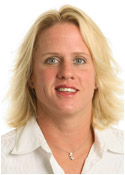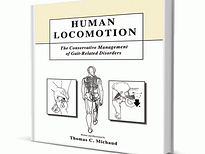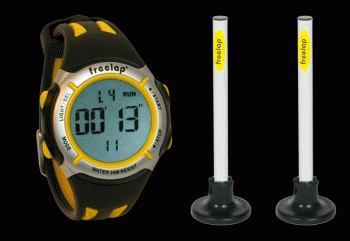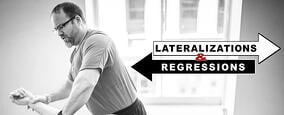by Craig Liebenson
Mid-Thoracic Dysfunction: A Key Perpetuating Factor of Pain in the Locomotor System
Dysfunction involving excessive T4-T8 kyphosis is common. Symptoms arising from regions at a distance to the mid-thoracic area are often secondary to T4-T8 dysfunction. This article will discuss why (rationale), when (indications), what (skills), and how (practical integration) T4-8 dysfunction is addressed.
Why
Mid-thoracic dysfunction involves increased kyphosis of the thoracic spine from T4-T8, usually the result of prolonged sitting in a constrained posture. Thoracic, lumbopelvic and cervicocranial posture are interrelated as links in a chain (see Figure 1). When excessive slumping becomes habitual, according to Brügger, it is called the sternosymphyseal syndrome (Lewit 1996, 1999, Liebenson et al., 1998, Liebenson 1999).
 |
Mid-thoracic dysfunction affects the whole body's center of alignment and posture. Head and shoulder forward posture causes orofacial, neck and shoulder disorders; slumping affects breathing by leading to inhibition of the diaphragm and overactivation of the scalenes; and lumbar disc syndromes and nerve impingement have been shown to result from repetitive end-range flexion overload (Callaghan, McGill 2001).
When
Indications for treating the mid-thoracic region arise from postural analysis, passive joint mobility testing, and active joint mobility testing. The postural sign of increased thoracolumbar hypertonus is a classic sign of overactivity of the superficial "global" muscles and indicates poor "deep" muscle function (Janda 1996, Richardson 1999, Jull 2000, Hodges 2002).
 |
Palpation of passive joint mobility and quality of end-feel is best performed in the seated position, as shown by Brügger (Brügger 2000).
 |
The dynamic mobility screen of choice is the standing arm elevation test (Liebenson 2001).
 |
What
Managing T4-8 dysfunction requires a broad skill set incorporating postural advice, manual manipulation, and therapeutic exercise.
Sample Exercises for Improving T4-8 Extension Mobility
- Brügger relief position - beginner

- Back stretch on the ball - intermediate

- Kolár's wall slide with arm elevation - advanced

How
Knowing why mid-thoracic dysfunction is clinically important, when it should be addressed, and what techniques are therapeutic is only the beginning point for successful management of the patient with a problem in this area. Satisfactory results will result from learning how to incorporate this knowledge and skill into patient care efficiently. A moment or two per session spent explaining the relationship between function and pain is one such step. Each exercise requires a unique "report of findings" to motivate the patient to incorporate it into his or her daily routine.
The Brügger relief position is an ideal workplace "micro-break." It activates an entire chain of muscles linked to the upright posture. To prevent the tendency to hyperextend the lumbar spine with this exercise, it should be performed with active exhalation.
The back stretch on the ball is comfortable and relaxing. It promotes improved respiration. It can cause dizziness at first, so the patient should be guided slowly onto it until he or she has learned how to balance on the ball.
Kolár's wall slide with arm elevation is a functional exercise, since it combines arm elevation, squatting and breathing. Patients typically feel a nice stretch in the lattismus dorsi with this exercise.
Summary
T4-8 dysfunction is a common source of muscle imbalance, trigger points, joint dysfunction, and faulty movement patterns. While often asymptomatic, it is nonetheless a key source of biomechanical overload involving the neck, TMJ, shoulder, arm, and even low back regions. Treatments which aim only at the site of symptoms are bound to fail if function is disturbed due to excessive kyphosis in the mid-back.
Rehabilitation of the upright posture is fundamental to optimization of function in the locomotor system. Neurological programs for maintenance of the upright posture are "hard-wired" into the central nervous system, making rehabilitation of the mid-thoracic area of central importance, both biomechanically and neurophysiologically. The mid-thoracic region is "linked" to a multitude of common musculoskeletal pain syndromes, and the simple assessment and treatments shown here are an excellent complement to chiropractic practice.
References
- Brügger A. Lehrbuch der Funktionellen Storungen des Bewegungssystems. Brugger-Verlag GmbH, Zollikon, Benglen, 2000.
- Callaghan JP, McGill SM. Intervertebral disc herniation: studies on a porcine model exposed to highly repetitive flexion/extension motion with compressive force. Clinical Biomechanics 2001;16:28-37.
- Hodges PW, Jull GA. Motor relearning strategies for the rehabilitation of invertebral control of the spine. In Liebenson CS. Rehabilitaiton of the Spine: A Practitioner's Manual (2nd ed). Lippincott/Williams & Wilkins, Baltimore, sched pub 2002.
- Janda V 1996. The evaluation of muscle imbalance in Liebenson CS (ed) Rehabilitation of the Spine: A Practitioner's Manual, Lippincott/Williams and Wilkins, Baltimore, 1996.
- Jull GA. Deep cervical flexor muscle dysfunction in whiplash. Journal of Musculoskeletal Pain 2000. 8:143-154,
- Lewit K 1996. The role of manipulation in spinal rehabilitation in Liebenson CS (ed) Rehabilitation of the Spine: A Practitioner's Manual, Lippincott/Williams and Wilkins, Baltimore.
- Lewit K 1999. Manipulative Therapy in Rehabilitation of the Motor System. 3rd edition. London: Butterworths.
- Liebenson CS, DeFranca C, Lefebvre R 1998. Rehabilitation of the Spine: Functional Evaluation of the Cervical Spine, Williams & Wilkins, Baltimore.
- Liebenson CS, Advice for the clinician and patient: The Brugger relief position. Journal of Bodywork and Movement Therapies 1999. 3:147-149.
- Liebenson CS, Advice for the clinician and patient: Self-treatment of mid-thoracic dysfunction: a key link in the body axis. Journal of Bodywork and Movement Therapies 2001. 5:90-100.
- Richardson C, Jull G, Hides J, Hodges P 1999. Therapeutic Exercise for Spinal Stabilization in Lower Back Pain, Churchill Livingstone.
See Craig Liebenson speak at the 2012 BSMPG Summer Seminar this May 19-20 in Boston MA.

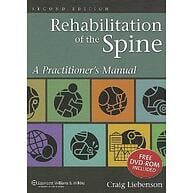
SPONSORED BY:
CRAIG LIEBENSON
LA Sports and Spine
Keynote Topic: Regional Interdependence: How Functional Pathology Limits Performance
Sunday Breakout Lecture: The Core as the Punctum Fixum in Sport: A Key to Making Movement Patterns More Efficient
Dr. Liebenson is an Adjunct Professor in the School of Chiropractic, Division of Health Sciences at Murdoch University, Perth Australia and consultant for the Murdoch University and the Anglo-European Chiropratic College M.Sc. program in Chiropractic Rehabilitation. The first ever chiropractic member of the McKenzie Institute (U.S.) Board of Directors, he serves on the editorial boards of numerous journals including the Journal of Occupational Rehabilitation; the PM&R Journal of Injury, Function and Rehabilitation; the Journal of Bodywork and Movement Therapy; and Journal of Manual Therapy.
Dr. Liebenson is the first health care provider to receive a Certification of Recognition from the National Committee for Quality Assurance (NCQA) on Achievement of Recognition for Delivery of Quality Back Pain Care. He is actively engaged in ongoing research on the spinal stabilization system as a Visiting Scholar at Pr. Stuart McGill’s Spine Biomechanics Laboratory at the University of Waterloo. He regularly assists Pavel Kolar in his courses and has worked with both Dr. Karel Lewit and Pr Vladimir Janda beginning in 1987. Dr. Liebenson publishes extensively and is the editor of the book/DVD Rehabilitation of the Spine: A Practioner's Manual (2nd ed), 2007.
He has had books published into Spanish, Greek, Korean and Japanese. He was the team chiropractor for the N.B.A. Los Angeles Clippers from the 2006-2007 season until 2009-2010 seasons and is currently a consultant for the M.L.B. Arizona Diamondbacks and Athletes Performance International.




